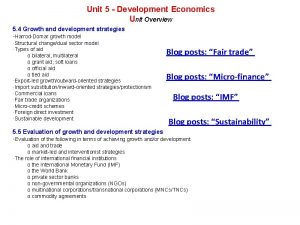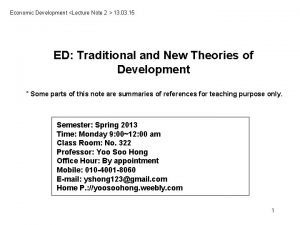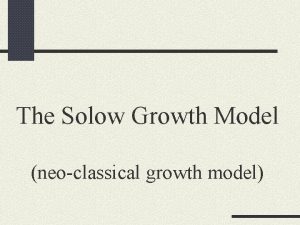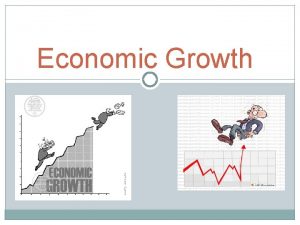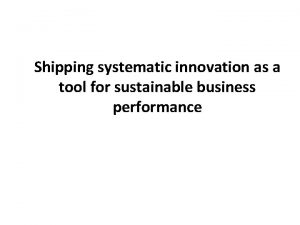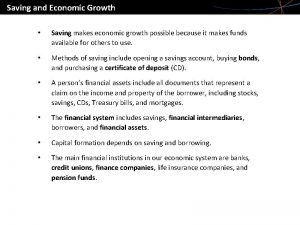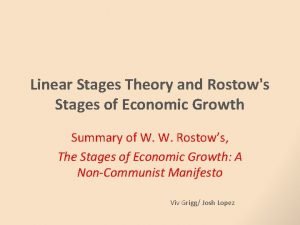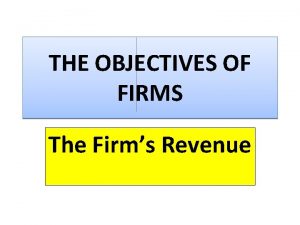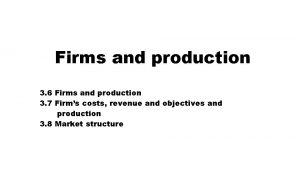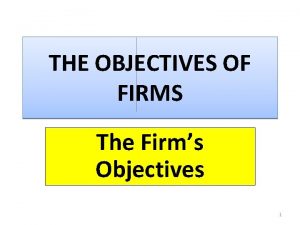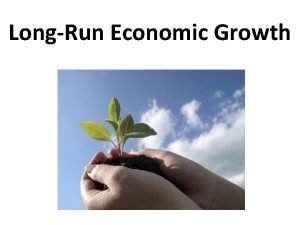UNIT FIVE GROWTH OF FIRMS ECONOMIC GROWTH An































- Slides: 31

UNIT FIVE GROWTH OF FIRMS

ECONOMIC GROWTH • An increase in the capacity of an economy to produce goods and services, compared from one period of time to another. Economic growth can be measured in nominal terms, which include inflation, or in real terms, which are adjusted for inflation. For comparing one country's economic growth to another, GDP or GNP per capita should be used as these take into account population differences between countries.

GROWTH OF FIRMS • A company that is growing at a rapid pace compared to its peers or to the broad economy. Although there is no hard-and-fast rule for defining growth, a growth firm generally has the capability to increase annual revenues by more than the industry average over a sustained period. A firm would not be classified as a growth firm on the basis of a one-time surge in revenues; rather, growth has to be demonstrated over a number of years.

FIRMS CAN GROW IN ONE OF TWO WAYS: • Internal growth. • External growth.

INTERNAL GROWTH. • This requires an increase in sales. In order to do this the firm will have to promote existing products and launch new products, this will require an increase in productive capacity. It can finance growth via borrowing, retaining profits (internal funds) or issuing new shares.

EXTERNAL GROWTH • Mergers and takeovers are ways in which businesses can grow externally and grow by joining together to form one company. • Mergers are mutual agreements between the companies involved to join together. Most takeovers tend to be hostile, in that the company being taken over does not want to be bought by the larger business. Takeovers do not need to be and are not always hostile, as some in fact can be friendly, in that the company being taken over wants to be taken over and can even ask to be taken over.

WHY DO COMPANIES JOIN TOGETHER? ØIt is the quickest and easiest way to expand. ØBuying a smaller competitor is normally cheaper than growing internally. ØSimple survival – survival of the fittest. To continue in the market the company may need to grow and the easiest way is to buy up someone else.

Ø The main aim of the business may be expansion. Ø Investment purposes. Buying up other businesses is a form of investment. Ø To prepare for the European Single Market. Ø To asset strip. Some companies buy other companies in order to sell off the most profitable assets of the business and make a profit. Ø To gain economies of scale.

MEASUREMENT OF ECONOMIC GROWTH • Expenditures: purchases of all the economy's goods and services {Expenditure Approach}. • Income: compensation to the owners of all inputs into the production process {Income Approach}.

MAJOR DETERMINANTS OF THE EXPENDITURE APPROACH • • Y=C+I+G+X–M GDP = Y What is Y? --- NATIONAL INCOME C---PRIVATE CONSUMPTION I----PRIVATE INVESTMENTS G---GOVERNMENT SPENDING X—M----NET EXPORT

• C -- Personal Consumption Expenditures: • Durable Goods • Nondurable Goods • Services • I -- Gross private domestic investment • Fixed Investment – Business Investment – Residential Construction • Change in Business Inventories

• X-M -- Net Export • Exports • Imports • G -- Government Consumption Expenditures and Gross Investment -- what is actually produced for the government; excludes transfer payments • Federal • State and Local

COMPONENTS OF GDP, 1999: THE EXPENDITURE APPROACH Components of GDP, 2002: The Expenditure Approach Personal consumption expenditures (C) Durable goods Nondurable goods Services Gross private domestic investment (l) Nonresidential Residential Change in business inventories Government consumption and gross investment (G) Federal State and local Net exports (EX – IM) Exports (EX) Imports (IM) Total gross domestic product (GDP) Note: Numbers may not add exactly because of rounding. 13 of 38 U. S. Department of Commerce, Bureau of Economic Analysis. Source: BILLIONS OF DOLLARS PERCENTAGE OF GDP 7303. 7 871. 9 2115. 0 4316. 8 1543. 2 1117. 4 471. 9 3. 9 1972. 9 693. 7 1279. 2 - 423. 6 1014. 9 1438. 5 10446. 2 69. 9 8. 3 20. 2 41. 3 14. 8 10. 7 4. 5 0 18. 9 6. 6 12. 2 - 4. 1 9. 8 13. 8 100. 0

INCOME APPROACH • Income received by the factors of production is as follows: Labour earns wages (sometimes called compensation of employees) Capital earns interest Land earns rent • Also, firms earn profits, which remain within the circular flow

• NI = Wages + Interest + Rent + Proprietors' Income + Corporate Profits

MEASUREMENT OF FIRM’S GROWTH • • • Long-Term Earnings Growth Historical Earnings Growth Sales Growth Cash Flow Growth Book Value Growth

LONG-TERM EARNINGS GROWTH • Earnings are what's left of a firm's revenues after it pays all of its expenses, costs, and taxes. Companies whose earnings grow faster than those of their industry peers usually see better price performance for their stocks

HISTORICAL EARNINGS GROWTH • Historical earnings growth shows the rate of increase in a company's earnings per share, based on up to four periodic time periods. • This measure helps determine our growth score for each stock and the overall growth orientation of the fund.

SALES GROWTH • Sales growth shows the rate of increase in a company's sales per share, based on up to four periodic time periods, and is considered the best gauge of how rapidly a company's core business is growing.

CASH FLOW GROWTH • Cash flow tells you how much cash a business is actually generating its earnings before depreciation, amortization, and noncash charges. Sometimes called cash earnings, it's considered a gauge of liquidity and solvency. Cash-flow growth shows the rate of increase in a company's cash flow per share, based on up to four time periods.

BOOK VALUE GROWTH • Book value is, in theory, what would be left over for shareholders if a company shut down its operations, paid off all its creditors, collected from all its debtors, and liquidated itself. In practice, however, the value of assets and liabilities can change substantially from when they are first recorded. Book value growth shows the rate of increase in a company's book value per share, based on and up to four periodic time periods.

ECONOMIES OF LARGE-SCALE PRODUCTION • Economies of Scale are the cost advantages that enterprises obtain due to size, output, or scale of operation, with cost per unit of output generally decreasing with increasing scale as fixed costs are spread out over more units of output. • Often operational efficiency is also greater with increasing scale, leading to lower variable cost as well.

• Economies of scale apply to a variety of organizational and business situations and at various levels, such as a business or manufacturing unit, plant or an entire enterprise. For example, a large manufacturing facility would be expected to have a lower cost per unit of output than a smaller facility, all other factors being equal, while a company with many facilities should have a cost advantage over a competitor with fewer.

Diseconomies of large scale production • Increase in long-term average cost of production as the scale of operations increases beyond a certain level. This anomaly may be caused by factors such as (1) over-crowding where men and machines get in each other's way, (2) greater wastage due to lack of coordination, or (3) a mismatch between the optimum outputs of different operations.

Sources of economies and diseconomies of scale • Bulk buying. This is probably the most straightforward one. If you go to a cash and carry warehouse, and buy large quantities of a good, the price per unit is smaller. Technical. Imagine that you have found the capital to buy a car factory, but you do not have enough money to have it running at full capacity. You probably can't afford enough workers to have all the machines working at once. This means there is less scope for specialisation, which improves labour productivity.

• Financial. Larger firms will find it easy to borrow money for further investment, or to extend their overdraft when there are cash flow problems. The larger the firm, the 'safer' they look to banks; they probably have more collateral on which to base a loan. Also, the interest rates that they pay will probably be lower.

• Managerial. When a firm is small, the manager is probably the owner. Not only will he direct his staff, but also he will probably run the office too and perhaps even do the accounts. As the firm gets bigger, he can begin to appoint specialist managers, an office manager, a typist and an accountant.

• Marketing. As a firm grows, its marketing costs will probably rise, but not at the same rate as the growth in the company generally. In other words, it is spreading these marketing costs over a larger output, reducing average costs. British Telecom has loads of adverts on the TV, but does it really have more than it did, for example, five years ago?

THE SOURCES OF DISECONOMIES OF SCALE • In this section we are looking at reasons why, as a result of getting too big, a firm might find that its average cost rises.

• Managerial. This is the main point. As firms get really big, the men (and women) at the top become more remote. They are not so well informed as to how their large numbers of workers are performing. I would not be surprised if some Virgin employees slip off for a two hour lunch occasionally, especially if they get on with their immediate boss quite well, but does Richard Branson know about this? In a small firm the boss can control every element of the business. Branson cannot do that anymore. Obviously some system of continual appraisal would be required so that every level of management is kept on its toes.

• Geography. Some textbooks use this point. Bigger firms often have bases in many parts of the UK, or even internationally. The huge increase in their transport costs and costs of communication may cause their aver age cost curve to rise.
 Economic growth vs economic development
Economic growth vs economic development Economic growth and development
Economic growth and development Application of harrod-domar model in developing countries
Application of harrod-domar model in developing countries Rostow's development model
Rostow's development model Chapter 1 lesson 2 our economic choices worksheet answers
Chapter 1 lesson 2 our economic choices worksheet answers Five kingdom economic principles
Five kingdom economic principles Five fundamental questions of economics
Five fundamental questions of economics These beauteous forms
These beauteous forms Five of five
Five of five Five elements and five senses
Five elements and five senses Macbeth seyton i am sick at heart
Macbeth seyton i am sick at heart Unit 6 review questions
Unit 6 review questions Aggregate production function
Aggregate production function Ssema
Ssema Ppc curve economic growth
Ppc curve economic growth Long run economic growth
Long run economic growth Long run economic growth graph
Long run economic growth graph Solow model of economic growth
Solow model of economic growth Solow model of economic growth
Solow model of economic growth Long run economic growth graph
Long run economic growth graph Real business cycle theory
Real business cycle theory Why is economic growth important
Why is economic growth important Brazil's quest for economic growth
Brazil's quest for economic growth Economic growth is defined as
Economic growth is defined as Economic growth is defined as
Economic growth is defined as Economic growth and development
Economic growth and development Economic growth occurs when
Economic growth occurs when Wallerstein's world systems theory
Wallerstein's world systems theory Economic growth trends
Economic growth trends Chapter 13 economic instability
Chapter 13 economic instability Saving makes economic growth possible because
Saving makes economic growth possible because What are the 5 stages of rostow's model
What are the 5 stages of rostow's model


